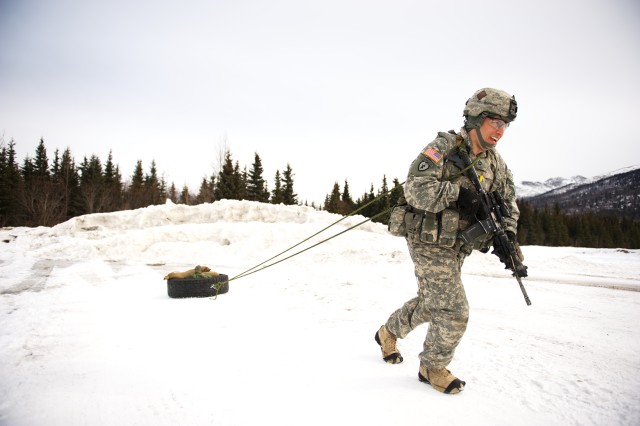JOINT BASE ELMENDORF-RICHARDSON, Alaska -- Sgt. Michael Hammonds, A Company, 1st Battalion, 501st Infantry Regiment (Airborne), breathed sharply as he labored under the weight of an 80-pound duffel bag during a 200-meter simulated buddy carry.
He threw the green "casualty" down with a groan of relief before running to the range ready line to get into a kneeling position.
Fighting a machine gun heartbeat and labored breathing, Hammonds peered through his optic. The reticle jumped and wagged.
The paratrooper remembered his training, he breathed with more control and waited for the crosshairs to find their mark.
Plink. Plink. Two rounds which sounded from his M-4 carbine found their mark in the steel man-shaped targets.
Though perhaps sounding more like a challenge from the television show "Sharp Shooters," the elaborate training scenario was part of last week's A Company range density training.
Capt. David Stroud, A Company commander, said the training was designed to increase confidence and proficiency with small arms and grenades.
"Range density training is focused on individual marksmanship with Soldiers," Stroud said. "It's basically the foundation of marksmanship for not only the younger Soldiers, but the older Soldiers as well that haven't shot, maybe, in the last couple of months."
To that end, Stroud said the training included the precise zeroing of the company's weapons, ensuring the strike of the bullet matched the optics' reticle patterns.
Soldiers then graduated to the known distance range, where they gained confidence in being able to consistently hit targets at 100, 200 and 300 meters.
The capstone event was qualification, when Soldiers were expected to engage a series of 40 popup targets requiring 36 hits to qualify expert. Soldiers also qualified with hand grenades.
The company didn't stop there, Stroud said, because infantrymen are often judged for their skills with their assigned weapons.
"The fundamentals of marksmanship are important because that's exactly what we do," the commander said.
"When we go overseas, we want to be able to see whatever enemy it is - at 300 meters, 200 meters, whatever distance - and be confident in our ability to be able to shoot and kill the enemy."
Army 2nd Lt. Caleb Sheffield, A Company range safety officer, said all of the skills honed during the course of the week culminated at the stress shoot range, designed to simulate marksmanship under combat conditions.
"The intent of this range is to distinctly show the difference between a qualification range and how we're more likely to fire in combat," Sheffield explained.
"That is with elevated stress levels, elevated heart rate, tunnel vision, things like that. So when you get the heart rate up around 150 to 170, you can see a really big difference in fine motor skills and situational awareness."
Sheffield said the first stage of the stress shoot was the casualty drag. Because the litter works so well on snow and ice, Soldiers were required to drag a Humvee tire filled with sandbags to simulate the resistance encountered when dragging a casualty on sand.
"Obviously dragging a casualty in a Skedco on snow isn't all that difficult," Sheffield said.
"It will slide too well, so we swapped them out with something that will cause a little bit more resistance."
After completing the casualty drag, Soldiers immediately went into the rapid-fire transition lane, placing two controlled rounds into each of a series of three steel targets.
The paratroopers then carried two five-gallon water jugs, adding fatigue to the grip of their hands.
"(Soldiers) could be pulling a rope, could be carrying ammo cans, could be carrying water, sandbags, anything that you're going to use a grip for," Sheffield said.
Paratroopers then engaged targets at three different ranges with the rapid sequence determined by their coach.
Soldiers moved to the next and perhaps toughest leg, carrying a duffel bag laden with 80 pounds of sandbags for 200 meters before firing a transition range in the kneeling position.
The Soldiers finally ran a 200 meter unladen sprint before having to engage a single target, but with the non-dominant hand and eye.
When asked about the difficulty of the range following his turn through the gauntlet, a sweating Sheffield remained philosophical.
"Physically, it was tough," he said. "No matter who you are, your heart rate is going to get up. But it was doable.
The range requires you to settle that heart rate and requires you to settle your breath, but the targets are not unhittable."
Stroud said during the next few months, the company will move on to Expert Infantryman Badge training, team and squad live fire exercises, situational training exercises, platoon live fire exercises, company command and control training and finally a mission rehearsal exercise at Joint Readiness Training Center, Fort Polk, La. - all pursuant to a future combat deployment.
"All of these individual fundamentals that they're learning right now are going to carry over into those collective tasks in the future," he said.


Social Sharing